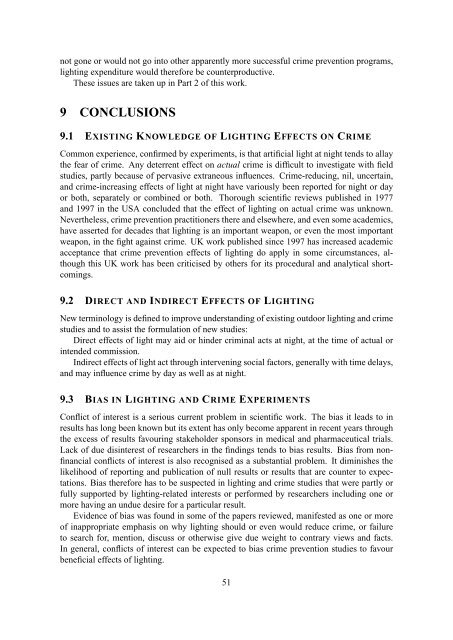outdoor lighting and crime, part 1 - Astronomical Society of Victoria
outdoor lighting and crime, part 1 - Astronomical Society of Victoria
outdoor lighting and crime, part 1 - Astronomical Society of Victoria
You also want an ePaper? Increase the reach of your titles
YUMPU automatically turns print PDFs into web optimized ePapers that Google loves.
not gone or would not go into other apparently more successful <strong>crime</strong> prevention programs,<br />
<strong>lighting</strong> expenditure would therefore be counterproductive.<br />
These issues are taken up in Part 2 <strong>of</strong> this work.<br />
9 CONCLUSIONS<br />
9.1 EXISTING KNOWLEDGE OF LIGHTING EFFECTS ON CRIME<br />
Common experience, confirmed by experiments, is that artificial light at night tends to allay<br />
the fear <strong>of</strong> <strong>crime</strong>. Any deterrent effect on actual <strong>crime</strong> is difficult to investigate with field<br />
studies, <strong>part</strong>ly because <strong>of</strong> pervasive extraneous influences. Crime-reducing, nil, uncertain,<br />
<strong>and</strong> <strong>crime</strong>-increasing effects <strong>of</strong> light at night have variously been reported for night or day<br />
or both, separately or combined or both. Thorough scientific reviews published in 1977<br />
<strong>and</strong> 1997 in the USA concluded that the effect <strong>of</strong> <strong>lighting</strong> on actual <strong>crime</strong> was unknown.<br />
Nevertheless, <strong>crime</strong> prevention practitioners there <strong>and</strong> elsewhere, <strong>and</strong> even some academics,<br />
have asserted for decades that <strong>lighting</strong> is an important weapon, or even the most important<br />
weapon, in the fight against <strong>crime</strong>. UK work published since 1997 has increased academic<br />
acceptance that <strong>crime</strong> prevention effects <strong>of</strong> <strong>lighting</strong> do apply in some circumstances, although<br />
this UK work has been criticised by others for its procedural <strong>and</strong> analytical shortcomings.<br />
9.2 DIRECT AND INDIRECT EFFECTS OF LIGHTING<br />
New terminology is defined to improve underst<strong>and</strong>ing <strong>of</strong> existing <strong>outdoor</strong> <strong>lighting</strong> <strong>and</strong> <strong>crime</strong><br />
studies <strong>and</strong> to assist the formulation <strong>of</strong> new studies:<br />
Direct effects <strong>of</strong> light may aid or hinder criminal acts at night, at the time <strong>of</strong> actual or<br />
intended commission.<br />
Indirect effects <strong>of</strong> light act through intervening social factors, generally with time delays,<br />
<strong>and</strong> may influence <strong>crime</strong> by day as well as at night.<br />
9.3 BIAS IN LIGHTING AND CRIME EXPERIMENTS<br />
Conflict <strong>of</strong> interest is a serious current problem in scientific work. The bias it leads to in<br />
results has long been known but its extent has only become apparent in recent years through<br />
the excess <strong>of</strong> results favouring stakeholder sponsors in medical <strong>and</strong> pharmaceutical trials.<br />
Lack <strong>of</strong> due disinterest <strong>of</strong> researchers in the findings tends to bias results. Bias from nonfinancial<br />
conflicts <strong>of</strong> interest is also recognised as a substantial problem. It diminishes the<br />
likelihood <strong>of</strong> reporting <strong>and</strong> publication <strong>of</strong> null results or results that are counter to expectations.<br />
Bias therefore has to be suspected in <strong>lighting</strong> <strong>and</strong> <strong>crime</strong> studies that were <strong>part</strong>ly or<br />
fully supported by <strong>lighting</strong>-related interests or performed by researchers including one or<br />
more having an undue desire for a <strong>part</strong>icular result.<br />
Evidence <strong>of</strong> bias was found in some <strong>of</strong> the papers reviewed, manifested as one or more<br />
<strong>of</strong> inappropriate emphasis on why <strong>lighting</strong> should or even would reduce <strong>crime</strong>, or failure<br />
to search for, mention, discuss or otherwise give due weight to contrary views <strong>and</strong> facts.<br />
In general, conflicts <strong>of</strong> interest can be expected to bias <strong>crime</strong> prevention studies to favour<br />
beneficial effects <strong>of</strong> <strong>lighting</strong>.<br />
51
















